WTF Millinery, part one
"WTF" as in Williamstown Theatre Festival, that is, not the more familiar expression.
WTF is a regional summer theatre in the Berkshires, and a frequent summer destination for Broadway performers and film stars who want to tread the boards in a regional company for a show or two. They won the Tony for a regional company in 2002, and they tend to strike a balance in their programming between classics and new premieres. (Incidentally, their Artistic Director is Nicholas Martin, who took over artistic direction at Boston's Huntington Theatre when i worked there ten years ago, small world.) WTF draws a lot of well-known costume designers, as well, so in a production context, working at WTF for a summer is a good way to get some prominent names on your resume, and have an opportunity to work with some top-rung talent and innovative creative teams.
One of my former grad students (M. Spencer Henderson, whose millinery work was featured in this blog a couple years back) is their shop manager this summer, and when a set of designs crossed his desk with some prominently-featured millinery, he called me for a bid. (WTF doesn't have a staff milliner.) I explained bid jobs in this earlier post, but basically, it's a name-your-flat-price sort of situation: you give me this much to make those items.
The show in question is George Kelly's The Torch-Bearers, a 1920s farce about amateur theatricals--like a flapper version of Waiting for Guffman...or something. I have permission from costume designer Ilona Somogyi to share some of her renderings, so that's exciting, because we can consider her designs as a jumping-off point to discuss the collaborative process of designer and production artist in the context of a distance bid like this one.

Costume design rendering by Ilona Somogyi, for the character "Nelly"

Costume design rendering by Ilona Somogyi, for the character "Florence"

Costume design rendering by Ilona Somogyi, for the character "Mrs. Ritter"
What a great trio of hats, eh? I should mention that in the play, the "Mrs Ritter" costume is exactly that: a costume. The character is playing a woman of the late 19th century and her outfit is of the OTT sight-gag variety. So, yes, she's definitely NOT a 1920s shape! I guess contextually, when the play came out initially in the 1920s, they would have looked at this outfit with the same sort of "OMG really we all dressed like that" sense that a modern audience feels when someone comes onstage in some extreme 1970s or 1980s fashion. Zany!
These renderings are interesting to look at juxtaposed with my previous post on CAD rendering techniques and programs--Ms. Somogyi's renderings are done in the traditional fashion, drawn by hand and watercolored, then scanned in. I admit an aesthetic preference for renderings created in this way, but i also recognize that--even as well-articulated as these are--it's hard to determine exact style lines from traditional renderings, especially on a hat. But! That is why designers also send research imagery, to support and augment their designs. Here are a couple examples of the ones that came along with these designs:
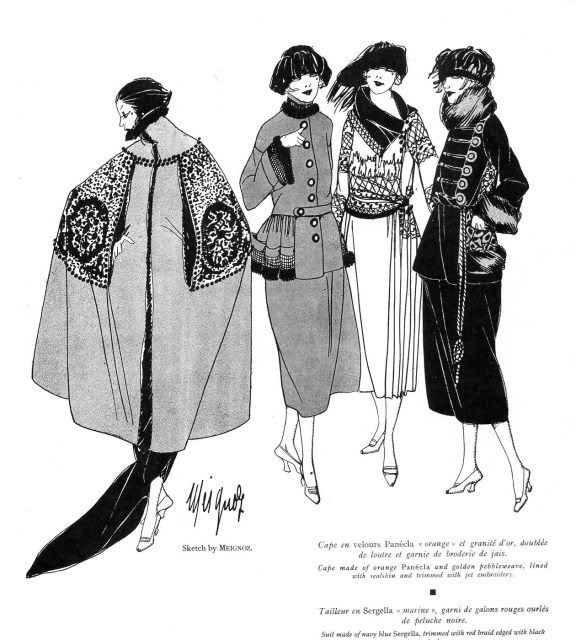
Period research in support of the "Florence" hat design
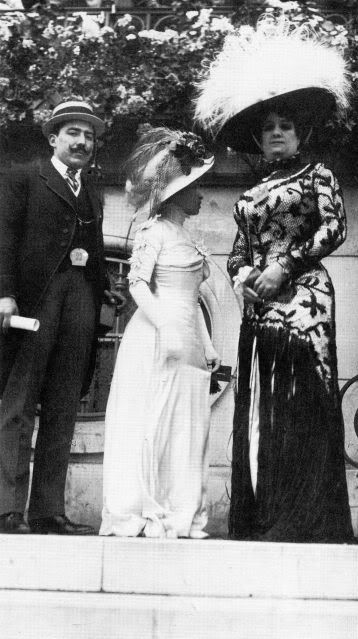
Period research in support of the "Mrs. Ritter" hat design
So, when mocking up these hats for WTF's first round of fittings, i had a fairly good idea of where to begin.
I have for some time now been working on an in-house studio space for millinery, because I wanted to be able to take more gigs like this one. (I can't work for other companies on bid jobs out of the studio space i have at PlayMakers.) I finally got it all set up just in time for this query to come through and me to accept it, so that's pretty cool! I figure i can book in jobs of this sort on a case-by-case basis, working around my extant obligations for PRC of course. And, in real-life news, i'm buying a house which, once i move in, will have an even larger studio space for such things! Pretty cool indeed.
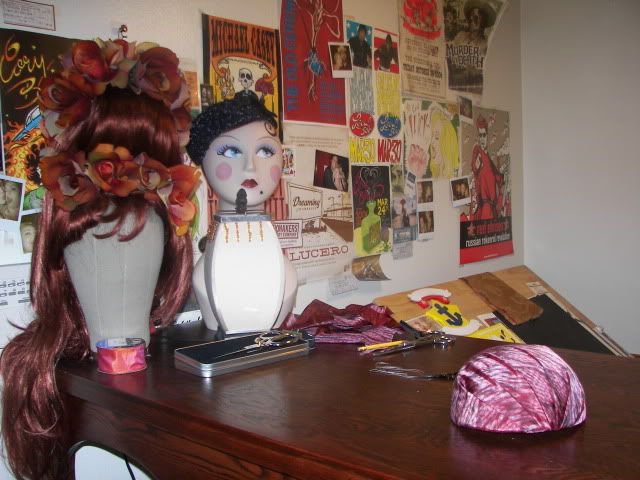
Studio space
My dolly head is wearing a crazy beehive wig from a previous post, and my 1920s repro mannequin's got a smart navy straw hat on. They're on a standing worktable, with my drafting board in background. I'll probably lose that wall collage when i move into the new studio--it's too busy. There's a hat crown in the foreground, which i'll talk about more in a forthcoming post.
But i was talking about mockups, and for this set of hats, i sent three mockups to WTF a couple weeks ago, for Spencer and Ilona to fit on the actresses and return with notes. There's a lot of trust involved with that sort of thing, not being present to fit your own hats, but i know Spencer did well in my millinery class so i felt confident with the process.
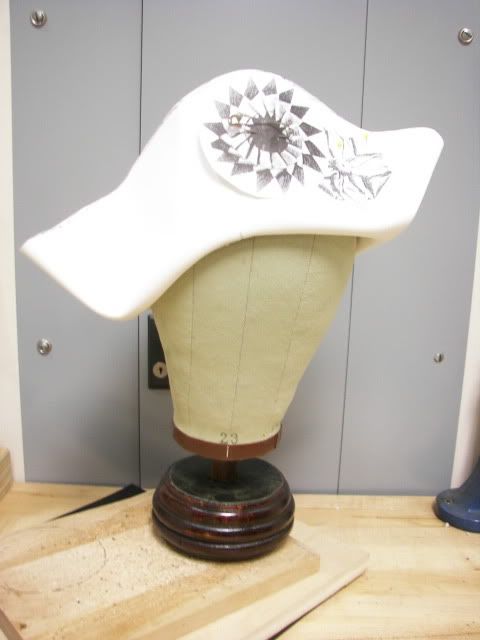
"Nelly" mockup of buckram and vinyl with xeroxed cockades

"Florence" mockup of buckram, panne, and track hair
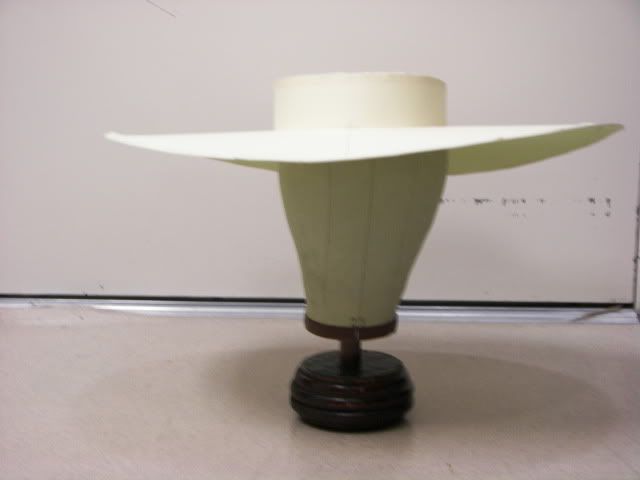
"Mrs. Ritter" mockup of oaktag, tape, and millinery wire
Mockups at this stage are--to my mind--about two things: fit and scale. I care about how they sit on the performer's head, and how the designer responds to elements of structure. Is the brim wide enough? Is the crown shape what s/he wants? Is there more or less padding involved in this area or that? Obviously we don't have any of the frou attached on top of that "Mrs Ritter" hat yet, in mockup stage, because first we care about the scale of the frou's foundation.
In the fittings, Spencer and Ilona drew on these mockups, cut into them, pinned up elements and moved others around, then shipped them back. They also took a bunch of photos of the mockups on the actress' heads in fittings from various angles so i could see them in context. (I won't be sharing those images, as i don't have the actress' permission to do so.) There was quite a pile of tulle photographed on top of that Ritter hat to illustrate the eventual scale of the trimming!
Things can change quite a bit in a mockup stage, which is why i hate to go straight into real materials. For example, if you look at the Florence cloche hat rendering, then the research, then the mockup, you can see the progression: i initially made the mockup going by the almost beret-like shape of the hat on the extreme right in the research. In the fittings though, Ilona and Spencer altered the mockup to look more like the hat second from left. Ilona and i also swapped emails and phonecalls so that all my questions were answered and so that she had a yardage plan for shopping fabrics.
The construction has begun, so i'll be posting soon about how these three hats came together in a North Carolina studio for performers on a stage 800 miles away.
For now though, have a great weekend!
WTF is a regional summer theatre in the Berkshires, and a frequent summer destination for Broadway performers and film stars who want to tread the boards in a regional company for a show or two. They won the Tony for a regional company in 2002, and they tend to strike a balance in their programming between classics and new premieres. (Incidentally, their Artistic Director is Nicholas Martin, who took over artistic direction at Boston's Huntington Theatre when i worked there ten years ago, small world.) WTF draws a lot of well-known costume designers, as well, so in a production context, working at WTF for a summer is a good way to get some prominent names on your resume, and have an opportunity to work with some top-rung talent and innovative creative teams.
One of my former grad students (M. Spencer Henderson, whose millinery work was featured in this blog a couple years back) is their shop manager this summer, and when a set of designs crossed his desk with some prominently-featured millinery, he called me for a bid. (WTF doesn't have a staff milliner.) I explained bid jobs in this earlier post, but basically, it's a name-your-flat-price sort of situation: you give me this much to make those items.
The show in question is George Kelly's The Torch-Bearers, a 1920s farce about amateur theatricals--like a flapper version of Waiting for Guffman...or something. I have permission from costume designer Ilona Somogyi to share some of her renderings, so that's exciting, because we can consider her designs as a jumping-off point to discuss the collaborative process of designer and production artist in the context of a distance bid like this one.

Costume design rendering by Ilona Somogyi, for the character "Nelly"

Costume design rendering by Ilona Somogyi, for the character "Florence"

Costume design rendering by Ilona Somogyi, for the character "Mrs. Ritter"
What a great trio of hats, eh? I should mention that in the play, the "Mrs Ritter" costume is exactly that: a costume. The character is playing a woman of the late 19th century and her outfit is of the OTT sight-gag variety. So, yes, she's definitely NOT a 1920s shape! I guess contextually, when the play came out initially in the 1920s, they would have looked at this outfit with the same sort of "OMG really we all dressed like that" sense that a modern audience feels when someone comes onstage in some extreme 1970s or 1980s fashion. Zany!
These renderings are interesting to look at juxtaposed with my previous post on CAD rendering techniques and programs--Ms. Somogyi's renderings are done in the traditional fashion, drawn by hand and watercolored, then scanned in. I admit an aesthetic preference for renderings created in this way, but i also recognize that--even as well-articulated as these are--it's hard to determine exact style lines from traditional renderings, especially on a hat. But! That is why designers also send research imagery, to support and augment their designs. Here are a couple examples of the ones that came along with these designs:

Period research in support of the "Florence" hat design

Period research in support of the "Mrs. Ritter" hat design
So, when mocking up these hats for WTF's first round of fittings, i had a fairly good idea of where to begin.
I have for some time now been working on an in-house studio space for millinery, because I wanted to be able to take more gigs like this one. (I can't work for other companies on bid jobs out of the studio space i have at PlayMakers.) I finally got it all set up just in time for this query to come through and me to accept it, so that's pretty cool! I figure i can book in jobs of this sort on a case-by-case basis, working around my extant obligations for PRC of course. And, in real-life news, i'm buying a house which, once i move in, will have an even larger studio space for such things! Pretty cool indeed.

Studio space
My dolly head is wearing a crazy beehive wig from a previous post, and my 1920s repro mannequin's got a smart navy straw hat on. They're on a standing worktable, with my drafting board in background. I'll probably lose that wall collage when i move into the new studio--it's too busy. There's a hat crown in the foreground, which i'll talk about more in a forthcoming post.
But i was talking about mockups, and for this set of hats, i sent three mockups to WTF a couple weeks ago, for Spencer and Ilona to fit on the actresses and return with notes. There's a lot of trust involved with that sort of thing, not being present to fit your own hats, but i know Spencer did well in my millinery class so i felt confident with the process.

"Nelly" mockup of buckram and vinyl with xeroxed cockades

"Florence" mockup of buckram, panne, and track hair

"Mrs. Ritter" mockup of oaktag, tape, and millinery wire
Mockups at this stage are--to my mind--about two things: fit and scale. I care about how they sit on the performer's head, and how the designer responds to elements of structure. Is the brim wide enough? Is the crown shape what s/he wants? Is there more or less padding involved in this area or that? Obviously we don't have any of the frou attached on top of that "Mrs Ritter" hat yet, in mockup stage, because first we care about the scale of the frou's foundation.
In the fittings, Spencer and Ilona drew on these mockups, cut into them, pinned up elements and moved others around, then shipped them back. They also took a bunch of photos of the mockups on the actress' heads in fittings from various angles so i could see them in context. (I won't be sharing those images, as i don't have the actress' permission to do so.) There was quite a pile of tulle photographed on top of that Ritter hat to illustrate the eventual scale of the trimming!
Things can change quite a bit in a mockup stage, which is why i hate to go straight into real materials. For example, if you look at the Florence cloche hat rendering, then the research, then the mockup, you can see the progression: i initially made the mockup going by the almost beret-like shape of the hat on the extreme right in the research. In the fittings though, Ilona and Spencer altered the mockup to look more like the hat second from left. Ilona and i also swapped emails and phonecalls so that all my questions were answered and so that she had a yardage plan for shopping fabrics.
The construction has begun, so i'll be posting soon about how these three hats came together in a North Carolina studio for performers on a stage 800 miles away.
For now though, have a great weekend!